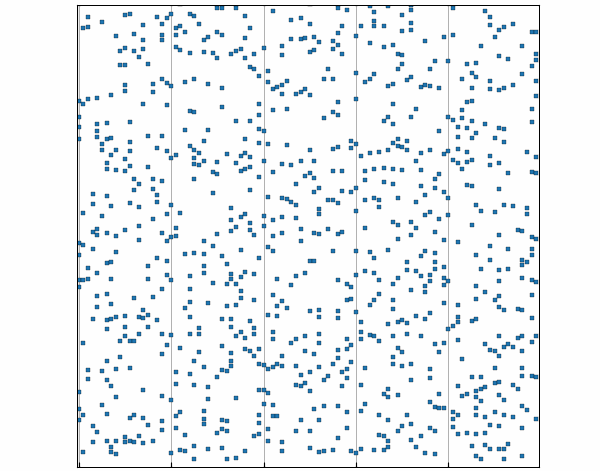
Dynamics of magnetization at infinite temperature in a Heisenberg spin chain
June 18, 2024
Eliott Rosenberg and Trond Andersen, Research Scientists, Google Research, Quantum AI team
Quick links
Would you be surprised to learn that growing wildfires are described by the same dynamical equations as snow falling and clumping together? Many systems that have different detailed dynamics behave similarly when viewed from a distance. For example, if you have a tub of cold water and you pour a cup of hot water into it, the heat will diffuse and equilibrate in a way that is largely insensitive to the microscopic details of water molecules. Over the last several decades, condensed matter physics has made great progress in classifying physical systems into universality classes with these sorts of common scaling behaviors.
The Kardar-Parisi-Zhang (KPZ) universality class, introduced in 1985 by its namesakes, describes the macroscopic behavior common to a variety of randomly growing interfaces, such as the examples of wildfires and snow accumulating mentioned above. Until recently, all systems in the KPZ universality class were thought to be classical and stochastic. Thus, the Heisenberg model, introduced by Werner Heisenberg in 1928 as a simplified model of interacting quantum magnets, e.g., quantum nuclei, was expected to be very different from typical systems in the KPZ universality class, since it is a quantum model with no randomness in the dynamics.
Surprisingly, however, in 2019, researchers at the University of Ljubljana in Slovenia found a striking resemblance between the way magnetization diffuses in a 1D spin-½ Heisenberg chain (quantum magnets arranged in a line, as displayed below) at infinite temperature and the mathematical predictions of KPZ universality. Their study, which was based on numerical simulations of the Heisenberg model, prompted several experimental groups to further test the conjecture that the Heisenberg model is in the KPZ universality class. These studies, including one that was published in Science, all found further evidence to support the conjecture.

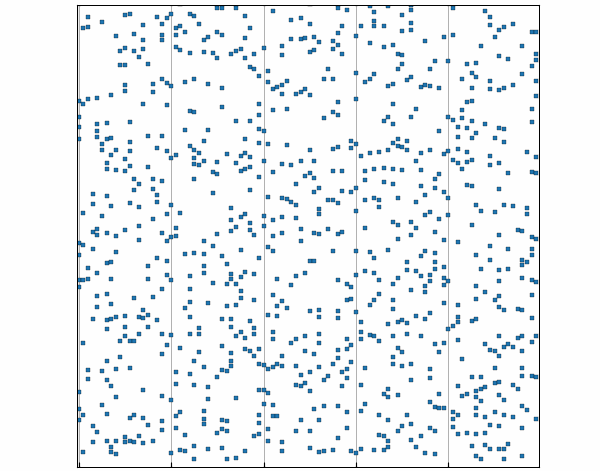
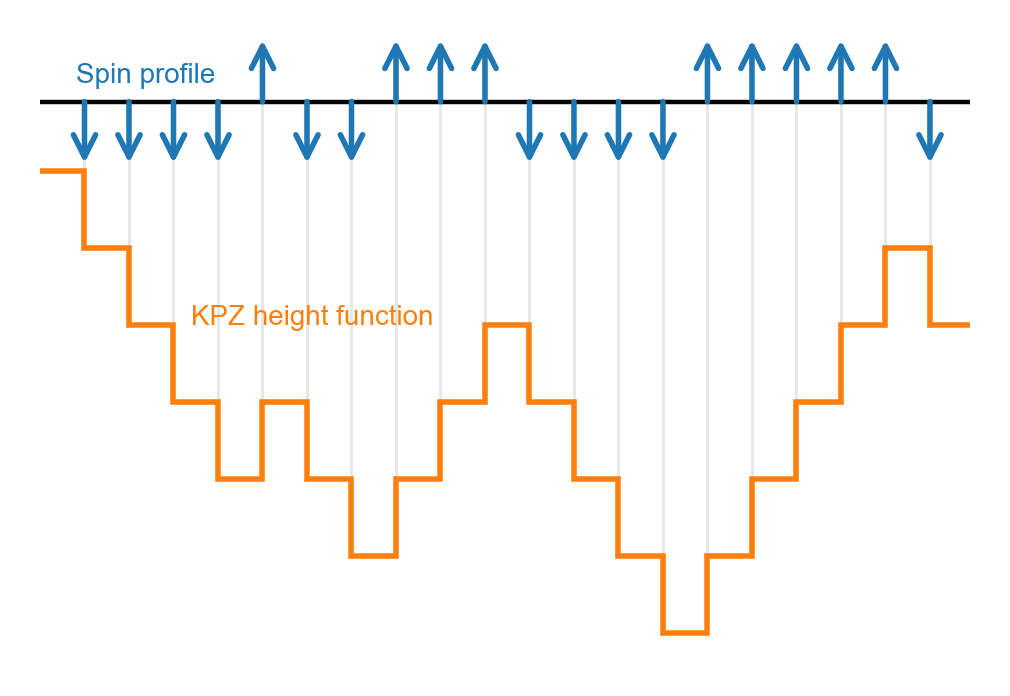
A system of interacting quantum magnets (top) was previously conjectured to share the same late-time, macroscopic behavior as snow falling and clumping together (middle). More specifically, the z-component of the spin was conjectured to correspond to the slope of the height profile of the snow as it piles up (correspondence illustrated in bottom panel).
Tomaž Prosen, one of the physicists from Ljubljana who originally proposed the conjecture, suspected, however, that if we looked more closely, we might find deviations from KPZ behavior in the Heisenberg spin chain. He, along with Sarang Gopalakrishnan from Princeton and Vedika Khemani from Stanford, approached Google Quantum AI and proposed that we run an experiment to probe more delicate observables that had so far been too difficult to study numerically and perform a more precise test of the KPZ conjecture.
In this experiment, now published in Science, we used a chain of 46 superconducting qubits to simulate a Heisenberg 1D chain. By resolving more delicate observables than were measured in earlier works, we were able to find the first signatures of deviation from KPZ universality.
Experimental setup
We implemented alternating layers of native fSim gates on a Sycamore processor to emulate the dynamics of the Heisenberg model. The initial states were parameterized by a number μ, which interpolates between the spins being all up on one side and all down on the other side (μ = ∞) and the infinite temperature state with each spin either up or down randomly with equal probability (μ = 0). We then measured how many spin-bits measured as 1s moved across the midpoint of the chain as a function of time, a quantity known as the transferred magnetization.
We simulate the Heisenberg model on our quantum processor using alternating layers of tunable fSim gates, as depicted in the circuit diagram on the left. We prepare the qubits in initial states parameterized by μ as depicted in the t=0 column of the middle panels. We then count how many 1s cross the center of the chain as a function of time, which we call the transferred magnetization. This is illustrated by the yellow squares moving from the bottom to the top with increasing time (i.e., cycle number) in the middle panels. The probability distribution of this quantity is shown on the right.
Mean and variance: consistent with KPZ
Our tunable fSim gates allowed us to study not only the Heisenberg model but also gave us the ability to explore the more general XXZ model. The XXZ model differs from the Heisenberg model in that the interactions can be stronger than or weaker than the hopping rate (which governs how fast the excitations move), whereas for the Heisenberg model they are equal. The strength of these interactions is characterized by Δ, which is equal to 1 for the Heisenberg model. We were thus able to reproduce several different expected behaviors, as identified by the mean and standard deviation of the distribution. Consistent with theoretical predictions and earlier experiments, we observed (panel A below) diffusive transport, akin to an ink drop spreading in water, when the interactions were strong (Δ>1), and unobstructed motion known as ballistic transport when the hopping was fast (Δ<1). Most importantly, at the Heisenberg point where the hopping and interactions are equally prominent (Δ=1), we observed a third type of dynamics, which is an intermediate of the two previous regimes and is known as superdiffusion. So far, this is consistent with the results of previous works and KPZ universality.
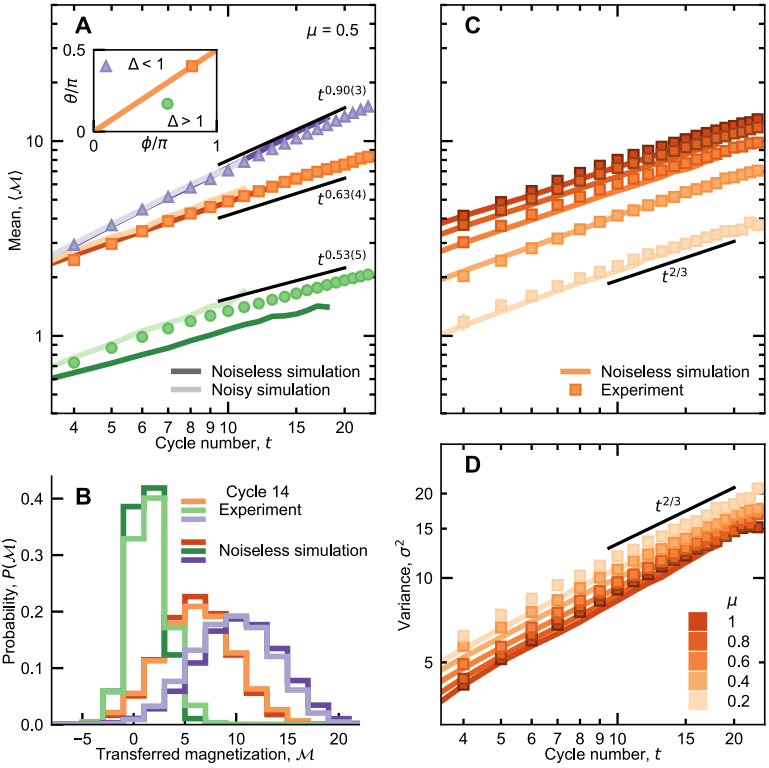
The mean (panels A and C) and variance (panel D) of the probability distribution (panel B) of transferred magnetization show the expected ballistic, diffusive, and superdiffusive behavior depending on the fSim gate parameters (inset to panel A), which control the relative strength of hopping versus interactions. In panel A, the expected exponents are 1, ½, and ⅔, respectively, close to what we observe, and in panels C and D, which show the mean and variance, respectively, at Δ=1 for different values of μ, the expected exponents are ⅔.
Higher moments: departure from KPZ
However, the fast data acquisition rate of our platform allowed us to also go beyond the mean and standard deviation to probe the distribution in more detail. Specifically, we were able to measure the skewness and kurtosis, which describe, respectively, the degree of asymmetry of the distribution and the dominance of its tail. Strikingly, we found that, on the timescale of our experiment, these were not consistent with the values expected for the KPZ universality class. In other words, while the distribution of the spin dynamics share some features with the one expected for KPZ behavior and might look the same at low statistics, they are not identical if one looks very carefully. The conclusion is therefore: the dynamics do not belong to the KPZ universality class.
Although all of the earlier experimental and numerical studies of the 1D Heisenberg spin chain at infinite temperature were consistent with the KPZ conjecture, some classical models also predicted deviation from KPZ universality in the skewness and kurtosis. These include a nonlinear fluctuating hydrodynamics (NLFH) model and the classical Landau-Lifshitz (CLL) magnet. Our experimental results, shown below, are consistent with the CLL model (dashed lines labeled “CLL”) and allow us to rule out the NLFH model (dashed lines labeled “NLFH”), enabling us to decide between competing classical models, in addition to ruling out KPZ (dashed lines labeled “KPZ”). The arrows on the dashed lines indicate in which limit of the x-axis the prediction is made. This marks one of the first times when a quantum processor was able to resolve an outstanding scientific question.
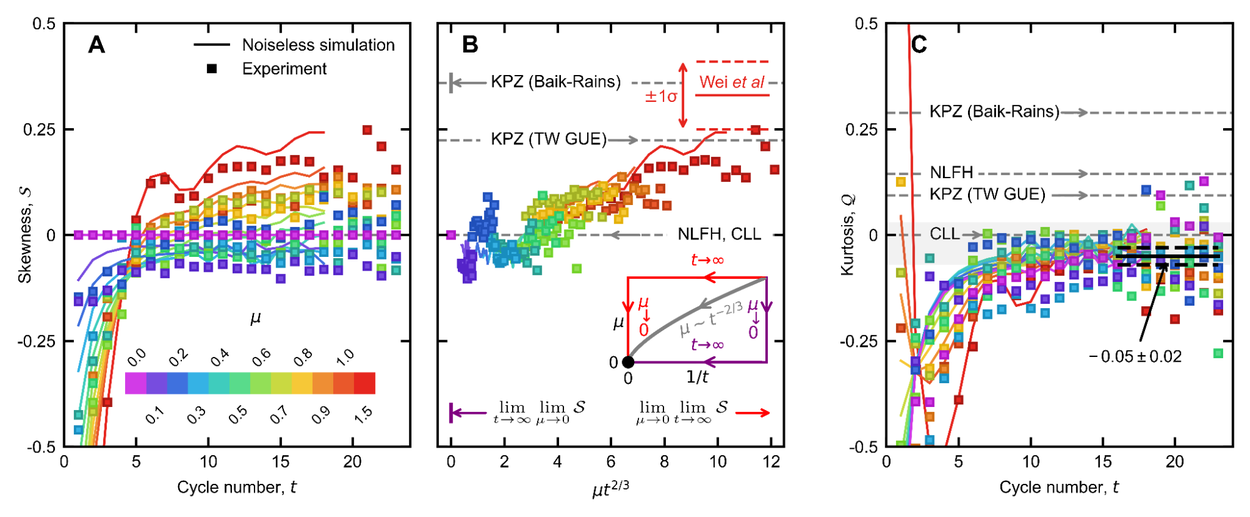
The skewness (panels A and B) and kurtosis (panel C) of the probability distribution of transferred magnetization, as functions of time. Dashed horizontal lines show various theoretical predictions, including those of KPZ universality. Whether the skewness is consistent with KPZ depends on the order of limits that one considers (inset to panel B, arrows on the dashed lines in panels B and C), but the kurtosis does not appear to approach the KPZ prediction. Instead, it, as well as the mean, variance, and skewness, appear to be consistent with a classical Landau-Lifshitz magnet model labeled CLL.
Conclusion
As we build quantum processors with ever improving fidelities and qubit counts, we are looking for additional useful applications of our devices. This work marks one of the first instances where a quantum processor was used to resolve an outstanding scientific debate in a different area of physics. As our devices continue to improve on the road toward an error-corrected quantum computer, we expect these discoveries to continue and lay the groundwork for increasingly useful future applications.
-
Labels:
- General Science
- Quantum



